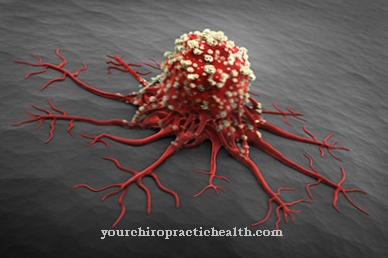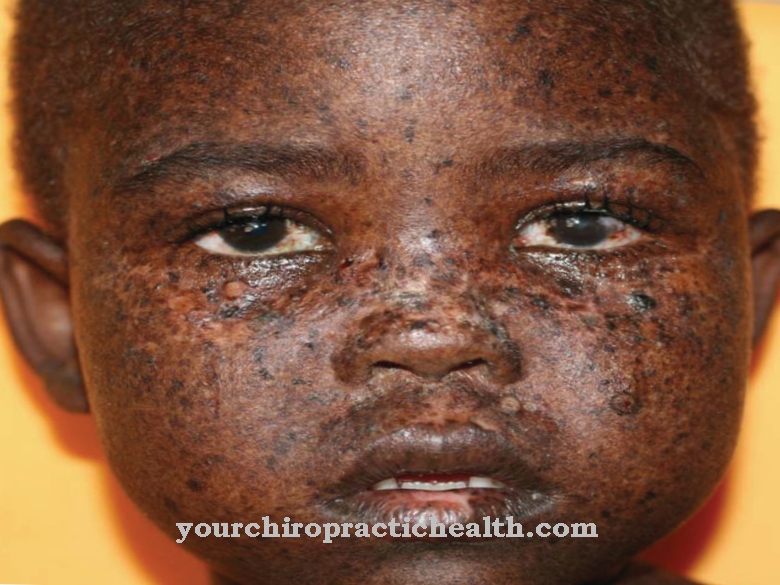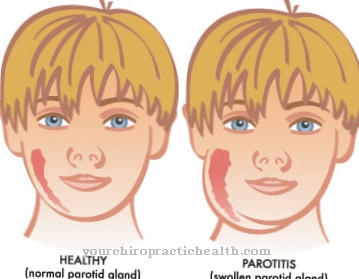3M syndrome is a very rare disease of the skeletal system. It is a hereditary disease that results in short stature. Changes in the face and back are particularly noticeable.
What is 3M Syndrome?

The 3M syndrome is one of the genetically determined forms of short stature. It is a syndrome with particular skeletal involvement. In medicine it is also called Dolichospondylar dysplasia, Gloomy Syndrome or Le Merrer Syndrome designated. It was named after the first American authors Miller, McKusick and Malvaux.
The disease was first described in 1975. The 3M syndrome is a very rare hereditary disease with a probability of 1: 1 million being diagnosed. It is inherited as an autosomal recessive trait. The disease can be diagnosed in the womb. It is characterized by a short stature.
A triangular face shape and other changes in the forehead, eyebrows and chin are characteristic already at birth. Later, changes in the neck, chest, vertebrae and joints appear in the course of growth. Despite various physical anomalies, the sick person's intelligence is normal. The severity of the symptoms and the number of abnormalities in short stature syndrome vary between patients.
causes
The cause of 3M syndrome is a genetic defect. Autosomal recessive mutations are inherited in three different genes. The recessive inheritance means that the genetic defect is not necessarily passed on from the parents to the child. As soon as a dominant allele in its characteristic expression prevails over the recessive allele during the development phase of the embryo, the outbreak of the disease is automatically prevented.
If the genetic defect prevails, however, three different types of 3M syndrome are distinguished. The syndrome can be caused by mutations in the CUL7 gene (type 1), OBSL1 gene (type 2) or CCDC8 gene (type 3). The occurring disorders and complaints are the same for all types.
Since the syndrome causes growth changes in the skeletal system, it has long been assumed that endocrine disorders are responsible. This has not yet been published or confirmed. The genetic defect is considered the only cause.
Symptoms, ailments & signs
Symptoms include severe stunted growth. These begin prenatally and continue postnatally. The short stature is considered proportionate. It is characterized by characteristic changes in the facial area and can be detected shortly after birth. Cranial features include a large head and triangular face shape.
The chin is pointed, the eyebrows are thick and the lips are full. The nostrils are usually directed upwards. The patient has a balcony forehead and midface hypoplasia. As the growth progresses, a short neck develops. The vertebral bodies are shortened and the bones like ribs are long and narrowed.
The shoulders have a square appearance and the trapezius is very noticeable. The thorax and the little fingers are shortened. The patient's joints are hypermotile and he has a funnel chest. All symptoms occur in the patients in individual forms and numbers.
Diagnosis & course
Before birth, the suspicion of 3M syndrome can already be expressed by the malformation ultrasound. The narrowing of the bones and ribs are determined via X-rays. Ultimately, the mutation is determined via the genetic test. The diagnosis of 3M syndrome has to be distinguished from floating harbor syndrome. This small growth syndrome also has language disorders that are not part of the symptoms of 3M syndrome.
When should you go to the doctor?
As a rule, 3M syndrome is diagnosed immediately after birth or through check-ups by a pediatrician. For this reason, in most cases no specific visit to the doctor is necessary. Those affected mainly suffer from deformations of the face and chest and also from short stature. If these complaints arise, a doctor must be consulted.
A doctor should always be consulted even in the event of general delays in the child's growth or development. This can prevent consequential damage in adulthood. It is not uncommon for the 3M syndrome to lead to language disorders. Speech disorders should also be examined and treated by a therapist to prevent bullying or teasing later on. The diagnosis of 3M syndrome is usually made by the general practitioner or the pediatrician. A specialist can then carry out further treatment of the individual symptoms and complaints. As a rule, various therapies are necessary to make everyday life easier for those affected.
Doctors & therapists in your area
Treatment & Therapy
3M syndrome cannot be completely cured. Various measures are taken to alleviate the symptoms and complaints. Usually a conservative and functional therapy is developed. The focus is on optical corrections and exercise therapy.
The treatment of 3M syndrome is accompanied by growth hormones. Successes have already been achieved in this way and the achievement of the final physical size of the patients has been positively changed. Surgical corrections are often required on the hands and face. However, due to the shortened neck, problems can arise during anesthesia that must be considered.
If the patient suffers from hypotonia, Vojta therapy is used. In this therapy, the therapist applies pressure to certain areas of the patient's body. This is in the prone, back or side position. These stimuli lead to two movement complexes, the reflex crawling and the reflex turning around.
In this way, the entire skeletal muscles are activated rhythmically. All spontaneous movements that the patient needs in everyday life are unconsciously addressed and trained. This includes the muscle functions in the spine, arms, legs, hands, feet and face. The aim of the therapy is to activate the elementary components of locomotion in the sick person through reflex locomotion.
In addition, psychotherapy is recommended for patients and relatives of someone with 3M syndrome. In particular, dealing with the disease and the cognitive coping options in everyday life are to be dealt with. Integration in a stable environment and participation in social activities are important for the sick person. By mentally strengthening the patient and his relatives, dealing with the disease is easier for everyone involved.
Outlook & forecast
The 3M syndrome causes various malformations and deformations on the patient's face. In most cases there is also a short stature, which can have a negative effect on the back. The growth retardation occurs at a very young age. This results in an above-average head and further deformations in the face. These can lead to psychological complaints or depression in the patient. It is not uncommon for children in particular to be teased and bullied and suffer severely from 3M syndrome.
The fingers are also shortened, which can lead to restrictions in mobility. The vertebrae on the back shorten, which can lead to pain and restrictions in movement.
Unfortunately, it is not possible to treat 3M syndrome causally. For this reason, treatment is only symptomatic, although not all complaints and symptoms can be limited. Sometimes the parents of the child concerned receive psychological support in order to prevent complications. Life expectancy is usually reduced by 3M syndrome.
prevention
As a preventive measure, parents can undergo a genetic test. As soon as the 3M syndrome has already occurred in the family, parents can have it checked whether they have the defective gene in them. No further preventive measures can be taken.
You can do that yourself
The symptoms of this particular form of short stature include growth retardations that start before birth. The phenomenon, which is called abnormal in society, needs a strong mind in order to be able to confidently master everyday life. Parents of affected children would do well not to put short stature in the foreground of their upbringing. Rather, they should teach their children to master the hurdles of everyday life quite naturally and confidently.
However, if a child's general growth retardation or developmental disorders appear, a pediatrician should be consulted. This may prevent consequential damage. An adequate therapist is responsible for diagnosing and treating any language disorders that occur. This later protects against teasing in kindergarten, school, training and work.
There is no cure for 3M syndrome, but there are various therapeutic approaches that can alleviate the symptoms and discomfort. These are usually functional and conservative treatments. The focus of the treatment is the optical correction. The sequence of movements can also be optimized. Any affected area of the body can be treated, but the gene mutation will always - more or less - remain visible. The mind is not affected, however, so everyday life can be mastered with self-acceptance and self-confidence as well as an adapted home furnishings and other practical aids.



.jpg)


.jpg)






.jpg)

.jpg)
.jpg)











.jpg)